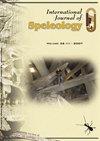从Prokletije山脉(黑山)的选定洞穴中识别碎屑沉积物来源区的尝试:矿物学和U-系列地球化学方法
IF 1.3
4区 地球科学
Q3 GEOSCIENCES, MULTIDISCIPLINARY
引用次数: 0
摘要
Prokletije山脉/阿尔巴尼亚阿尔卑斯山是迪纳里克山脉的最高部分。矛盾的是,这些山脉及其洞穴区仍然是欧洲最神秘的山脉之一,直到最近才成为科学研究和洞穴探索的主题。本文的重点是科拉塔和格雷本地块,那里是最高的,因此也是最古老的洞穴系统。通过对重矿物组成、磷灰石-电气石指数的分析,以及矿物组成和铀同位素数据的聚类分析,可以确定洞穴碎屑矿床的来源区。它还可以区分多个古水流方向,每个方向对应于洞穴发育的不同阶段。较古老的古水流可能是从南向北流动的,而较年轻的古水流则被推断是从东向西流动的。古沉积物输移方向的变化可能是由新近系构造运动引起的。在后期,由于Prokletije Mts的随后抬升及其破碎成单个地块,向洞穴的运输是局部的,并与冰川消融有关。Prokletije山脉最古老洞穴中的洞穴化石沉积发生在公元381年和308 ka(MIS 11和MIS 9)时期,这表明这些水平已经从潜水阶段过渡到包气阶段。考虑到所研究的洞穴形态,我们认为这些洞穴可能至少在中更新世开始形成。有两代较年轻的洞穴化石,第一代为163±4 ka(MIS 6),第二代为92±2至39.4±2 ka(Weichselian年龄)。本文章由计算机程序翻译,如有差异,请以英文原文为准。
An attempt to identify source areas of clastic deposits from selected caves of the Prokletije Mountains (Montenegro): a mineralogical and U-series geochemistry approach
The Prokletije Mountains/Albanian Alps are the highest part of the Dinaric Mountains. Paradoxically, these mountains and their cave areas remain among the most enigmatic in Europe, having only recently become subjects of scientific research and cave exploration. This paper focuses on the Kolata and Greben massifs, where the highest, and thus the oldest, cave systems are located. Through the analysis of heavy mineral composition, the apatite-tourmaline index, and cluster analysis for mineralogical composition and uranium isotopic data, it becomes possible to identify the source areas for the cave clastic deposits. It also allow to distinguish multiple paleoflow directions, each corresponding to different stages of cave development. The older paleoflow was probably from south to north, whereas the younger one is inferred to have flown from east to west. The change in the paleodirection of sediment transportation was probably caused by Neogene tectonic movements. In the later period, because of the subsequent uplift of the Prokletije Mts. and their fragmentation into individual massifs, the transport to the caves was local and related to deglaciations. The deposition of the speleothem from the oldest caves of the Prokletije Mts. took place in the periods c. 381 and 308 ka (MIS 11 and MIS 9), which suggests that these levels had already passed from the phreatic to the vadose stage. Considering the morphology of the caves studied, we believe that these caves may have begun to form at least in the Middle Pleistocene. There are two generations of younger speleothems first at 163 ± 4 ka (MIS 6) and second from 92 ± 2 to 39.4 ± 2 ka (Weichselian age).
求助全文
通过发布文献求助,成功后即可免费获取论文全文。
去求助
来源期刊

International Journal of Speleology
地学-地球科学综合
CiteScore
3.10
自引率
23.10%
发文量
12
审稿时长
>12 weeks
期刊介绍:
The International Journal of Speleology has the aim to get cave and karst science known to an increasing number of scientists and scholars. The journal therefore offers the opportunity to all scientists working in and on karst to publish their original research articles or their review papers in an open access, high quality peer reviewed scientific journal at no cost. The journal offers the authors online first, open access, a free PDF of their article, and a wide range of abstracting and indexing services.
 求助内容:
求助内容: 应助结果提醒方式:
应助结果提醒方式:


